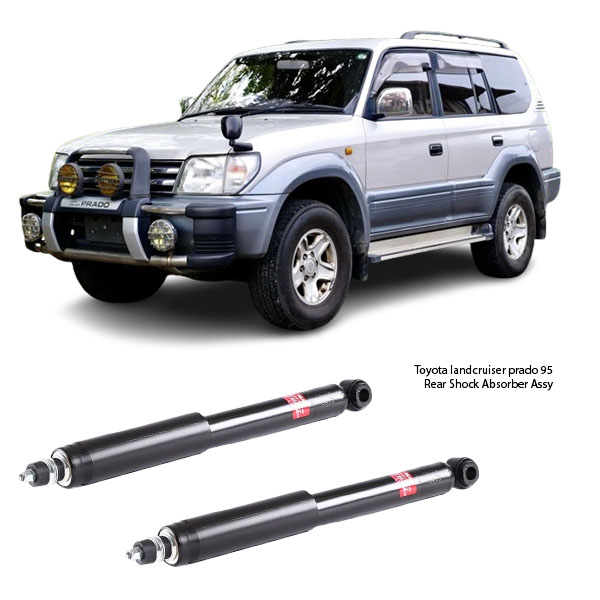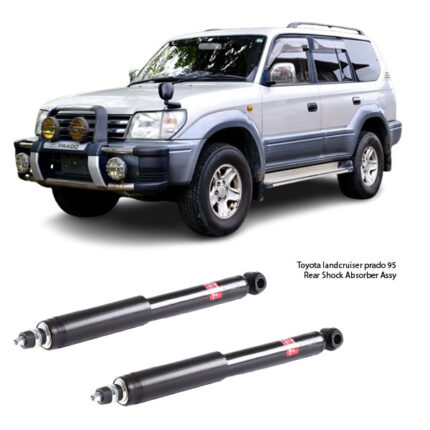Get Toyota Land Cruiser Prado 95 Series Rear Shock Absorber Assy 344288 in Kenya
A smooth and stable ride depends on your vehicle’s suspension system, and one of the most crucial components in that system is the Rear Shock Absorber Assembly. Whether you’re driving on rough terrain, highways, or city streets, the rear shock absorbers ensure that your vehicle maintains stability, absorbs road impacts, and provides a comfortable ride.
In this in-depth guide, we’ll explore everything about Rear Shock Absorber Assemblies – their function, components, types, symptoms of failure, replacement process, and why they matter for your vehicle’s overall performance.
What is a Rear Shock Absorber Assembly?
The rear shock absorber assembly is a part of your vehicle’s suspension system, designed to absorb road shocks and vibrations that affect the rear wheels. Its primary job is to keep the tires firmly planted on the road, ensuring better control, comfort, and handling.
Functions of a Rear Shock Absorber Assembly:
Dampens Road Vibrations – Reduces the impact of bumps and potholes.
Enhances Vehicle Stability – Prevents excessive bouncing and body roll.
Improves Ride Comfort – Ensures a smoother experience for passengers.
Reduces Tire Wear – Keeps tires in proper contact with the road.
Supports Braking Efficiency – Prevents nose-diving and swaying during braking.
Unlike front shock absorbers, rear shocks primarily stabilize the vehicle’s rear end, which is essential for maintaining balance, especially when carrying heavy loads or towing.
Components of a Rear Shock Absorber Assembly
The rear shock absorber assembly consists of several parts that work together to ensure proper damping and stability.
Main Components:
Shock Absorber (Damper) – The core component that absorbs road shocks.
Coil Spring (if applicable) – Provides additional suspension support.
Mounting Bushings & Bolts – Securely attach the shock absorber to the chassis.
Piston & Hydraulic Fluid – Absorb and control motion through hydraulic pressure.
Dust Boot & Bump Stop – Protects the shock from dirt and prevents bottoming out.
Some vehicles use separate coil springs and shock absorbers, while others use a coil-over design where both components are combined.
Types of Rear Shock Absorbers
There are different types of rear shock absorbers, each designed for specific driving needs and vehicle types.
Hydraulic Shock Absorbers (Oil-Filled)
Uses hydraulic fluid to absorb shocks.
Smooth and comfortable ride.
Can overheat with excessive use.
Gas-Filled Shock Absorbers (Gas-Charged)
Uses nitrogen gas to prevent foaming of hydraulic fluid.
More responsive and stable handling.
Slightly stiffer ride compared to hydraulic shocks.
Twin-Tube Shock Absorbers
Features an inner and outer tube for better damping.
Affordable and widely used in standard vehicles.
Less efficient heat dissipation than monotube shocks.
Monotube Shock Absorbers
Uses a single-tube design for better heat dissipation.
High-performance and great for off-road driving.
More expensive than twin-tube shocks.
Adjustable Shock Absorbers
Allows drivers to customize damping levels for different conditions.
Ideal for sports cars and heavy-duty applications.
Requires manual adjustments and higher cost.
Symptoms of a Failing Rear Shock Absorber
Like any vehicle component, rear shock absorbers wear out over time. Here are some common signs that indicate it’s time for a replacement:
Excessive Bouncing
If your vehicle bounces excessively after hitting a bump, your rear shocks are likely worn out.
Poor Handling & Stability
If your car feels unstable while driving, especially around turns, your shocks may not be absorbing road impacts properly.
Uneven Tire Wear
Faulty shocks can cause cupping or scalloping on the rear tires due to improper road contact.
Fluid Leaks from the Shock Absorbers
Visible oil leaks around the rear shocks indicate internal failure.
Strange Noises from the Rear Suspension
Clunking, knocking, or rattling sounds over bumps suggest worn-out shocks.
Rear End Squatting
If the rear of your vehicle sags excessively when carrying passengers or cargo, the shock absorbers may be failing.
Longer Braking Distance
Worn shocks reduce tire grip, increasing stopping distances and making braking less effective.
Ignoring these signs can compromise your safety and lead to more expensive repairs!
How to Replace a Rear Shock Absorber Assembly
Replacing a rear shock absorber is a moderate-level DIY task, but if you’re not comfortable working on your suspension, a mechanic can handle it for you.
Tools & Equipment Needed
Jack & Jack Stands
Lug Wrench
Socket Set & Ratchet
Torque Wrench
Penetrating Oil (for rusted bolts)
Step-by-Step Replacement Process
Park the Vehicle & Secure It
- Engage the handbrake and use wheel chocks.
Lift the Rear End & Remove the Wheels
- Use a jack to lift the vehicle and secure it with jack stands.
Locate & Remove the Old Rear Shock Absorber
- Remove the lower mounting bolt first, then the upper bolt.
- Use penetrating oil for stubborn bolts.
Install the New Rear Shock Absorber
- Align the new shock absorber correctly and secure it with bolts.
Torque the Bolts to Manufacturer Specifications
- Use a torque wrench to ensure proper tightness.
Reinstall the Wheels & Lower the Vehicle
- Make sure everything is securely tightened before driving.
Test Drive & Check for Issues
- Ensure smooth operation and listen for any unusual noises.
Follow us on Facebook for more parts.




